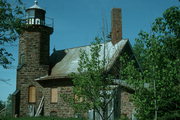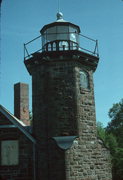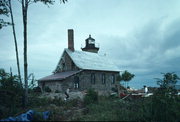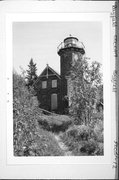| Additional Information: | A 'site file' exists for this property. It contains additional information such as correspondence, newspaper clippings, or historical information. It is a public record and may be viewed in person at the Wisconsin Historical Society, Division of Historic Preservation. INTEGRATED LIGHTHOUSE AND KEEPER'S DWELLING. LIGHT TOWER, POLYGONAL ABOVE, SET INTO CNR OF HOUSE. CHIMNEY PROJECTS AT REAR. HABS WI-313.
On a rocky promontory on the western edge of the Apostle Islands, the Sand Island Lighthouse is the most picturesque of the archipelago's seven light stations. In the 1880s, ship captains requested more navigational aids to guide them between Superior, Duluth, and the locks in Sault Ste. Marie, so Congress authorized the construction of this lighthouse. It appears to have been built from plans for the Chambers Island Lighthouse and the Eagle Bluff Lighthouse, both in the Green Bay-Lake Michigan corridor. The Gothic Revival structure consists of a Keeper’s Dwelling and a 44-foot tower, both built of Chequamegon brownstone. The steeply pitched gabled roof, scrolled knee braces, and an attenuated gable ornament with a turned pendant lend the building an uncommon stylishness. Its segmentally arched windows feature vermiculated voussoirs, a particularly artistic touch. Attached at one corner, the lighthouse tower begins as a square structure, then gracefully flows into an octagonal shape as it extends above the dwelling's gabled roof. A ten-sided lantern with an iron walkway crowns the structure. In 1921, the Bureau of Lighthouses replaced the Fresnel lens with an automatic acetylene light.
Most lighthouse keepers on the Apostle Islands lived isolated lives. But not here. Sand Island supported a year-round community of perhaps as many as one hundred farmers and fishermen. At the southeast tip was a summer resort, Camp Stella, where vacationers began coming in the late 1880s. A community of mostly Norwegian-immigrant families lived on East Bay. The island is one of twenty-one along the Apostle Islands National Lakeshore, which boasts some of the most pristine beaches and old-growth forests in the Great Lakes region.
Other buildings associated with the light: #243074, #243075, #243076
Covenant/Easement: From 7/18/1990 to 7/18/2005. A 'covenant file' exists for this property. It may contain additional information such as photos, drawings and correspondence. It is a public record and may be viewed in person at the Wisconsin Historical Society, State Historic Preservation Office. |
|---|





